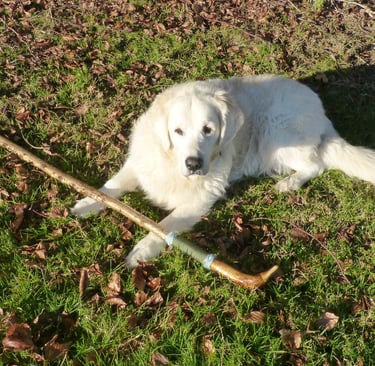Make your own staff
The top of the stick is thumb thick as a guide, although 19mm is what you are looking for.
Always my first consideration is ‘can I leave the bark on?’ Debark or not to debark, that is the question. ‘Be not afraid of greatness; go for it, my son,’ I think he said. Mother Nature has more idea than us, so if you can leave it alone, you will appreciate it later in its life. And friends will see it as more real, not contrived.
If your staff is seasoned it will be as light as it is going to get, if not, wait before you panic. Whichever, it will not lose its strength.
Whenever I make a new staff, and I am not sure if I have it right, I use it before finishing. After a mile of planting it every fourth, and chatting to my retriever (the best way to get control of a not come back dog), I may find it has become a natural extension of my arm; so somebody is going to love it. And that’s always a good feeling.
So…here we go…
First:
Is it straight enough?
If you have seen it as a staff, nurtured it in the corner of the shed, it probably is. If not, look online for easy options before getting excited by a steam chamber you’ll never use again.
One method often talked about is using a heat gun. Okay for a one off, however, if it is a working stick (some of mine are brutes) it maybe a long kob. Nevertheless, a straight stick always looks best so decosion time.
Tools;
I am not going to insult someone who has come this far and gone beyond the patience of a gnat that the internet suffers from; however, they are just the basics needed.
Preparation:
There is no need to remove every bump and lump until it is so smooth you might have well stripped the damn thing in the first place and painted it shabby sheik. Just make it so as not to have sharp bits, all loose flakes and you have cracked it. Leave the rest to finishing.
Length;
Is it long enough? Will it need a top? Want a grip?
One way to enhance, advertise your skill and add length to the staff is add a top.


Top Choices. Fixing first:-
Dowelling.......
Screwed Rod
Reversed wood screw. That’s half normally threaded and half reversed.
Or simply a large screw with the head cut off. Whichever, epoxy glue with enough on the thread to squeeze out and make the two mating surfaces.
Me? The dowel, which allows me to mark both for alignment, a couple of dummy runs to get the two to marry nicely, and push on. Drill bit half a mill under size for a good interference fit. And cut a V along the dowel to allow excess adhesive to squeeze out.


